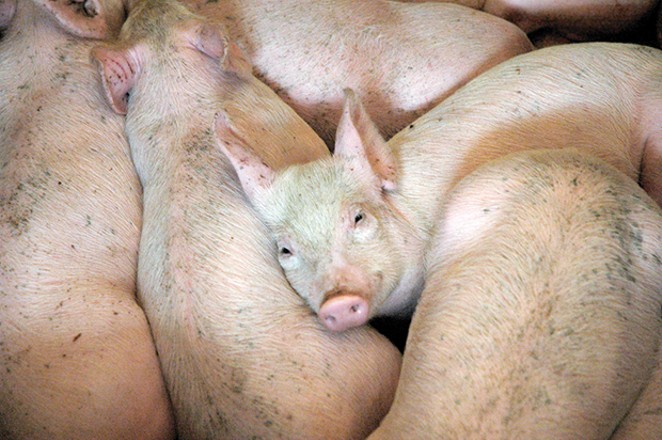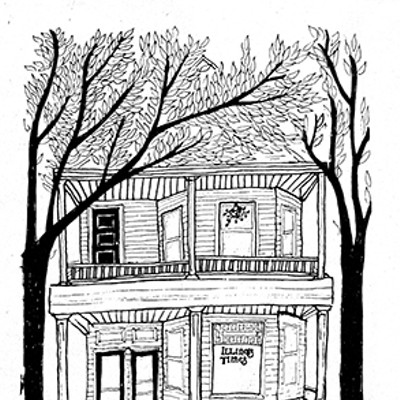I was at my desk in 1982 when the phone rang.
“Hello.”
“What the hell is a pork belly?”
It was Lewis Bergman, calling from New York City. Lewis was former editor of the New York Times Magazine who was then calling the shots at one of my magazines, the monthly published by the business think tank, The Conference Board. He had been reading the commodity futures in the Times that morning, as he had done for decades, and only that day realized that he didn’t know what a pork belly actually was. He called me because I lived in the Midwest, where, as everyone knew – or at least everyone Lewis knew – folks all have straw in their hair, chickens in the yard and a pig pen out back.
I had to disappoint Lewis by telling him that I knew nothing much about hogs, having grown up in my living room on Manor Avenue in Springfield watching TV from New York City. The only place I ever saw pork being slaughtered was in our kitchen after it was already dead, when Mom cooked our pork chops into leather. Still, I am among the uncountable central Illinois boys and girls who were never very far away from a farm and that meant being never far from hogs.
As a boy I spent weekends at my grandparents’ farm outside Beardstown. Grandpa ran an experimental feed station for the Critics Feeds company, which had a mill in town. I liked to tag along when Grandpa did his chores, one of which was to relieve newborn male piglets of their testicles. Porcine testosterone leaves a boar’s meat with a foul smell that renders it unpalatable, so off they had to come if the animal was to qualify for the table. Kind of what you have to go through to qualify for a college degree.
The hog manuals refer to “surgical removal” but Grandpa just used his pocketknife. He’d tuck a squealer under his arm, slice off the offending parts and toss them on to the ground, where they were gobbled up by the farm cats. This was life in the raw for a subdivision boy not far from the start of puberty. There were lessons to be learned from the spectacle, but I didn’t learn them from Grandpa, who never talked much. Only much later in life would I learn how much of life was in that operation, as when I contemplate the plight of members in a Rauniganized legislature.
As a boy fascinated by hogs I was born too late. Pigs once roamed loose in Springfield. Paul Angle explores the topic in Here I Have Lived, a book that, astonishingly, contains 40 references to hogs. A Springfield in which hogs were allowed to run loose – poor folks could thus raise their own meat that way – is cleaner but not fairer than a Springfield in which the only hogs running loose are feeding at the TIF trough.
The closest most of us town boys ever came to a living hog was the annual August tour of what we knew as the handsome pig barn at the state fair, but which is officially and more accurately known as the swine pavilion. These massive critters did nothing but sleep and eat while being tended by 4-H girls. Nothing more sublime could be imagined by a preteen male. It was there, I later confessed to my Chicago readers, that I finally got the point of farmer’s daughter jokes.
I am drawn away from my reveries by the thought that, in Illinois, hogs are a matter of public policy as well as private amusement. Hogs used to be a side business for most farmers, and only collectively could hog-raising be described as an industry. Today, alas, hogs are raised in industrial numbers in facilities using industrial methods, with industrial effects on local environments. It’s a grim fate for animals as intelligent as hogs. (Angle recalls the appearances in town of the “Learned Pig,” who could tell time, add and multiply, and play cards with anyone in the audience, which would have impressed me too, because I don’t know how to play cards.)
Opposition to these flesh factories is growing, which, presumably, was the point behind the resolution recently approved by the Illinois House to “recognize and continue to defend the importance of bacon . . . to the economy, job growth and the consumer preference of the people of Illinois.” Good to know we can count on our legislators to protect the interests of corporate Illinoisans, but judging from public health data, it is the consumers of Illinois who need protection against bacon.
We can argue about exactly how important bacon is to the economy. According to the Illinois Pork Producers Association, Illinois is home to no fewer than 4.6 million head of hogs, and that raising the beasts contributes nearly $2 billion to the state economy. That’s only about one three-hundredth of the state’s GDP. However, hogs contribute more than newspaper columnists, so I am in no position to sneer.
Oh, I forgot – the pork belly is just that, the hog’s belly. It’s the cheap part of the hog, fit for folks eatin’ low on the hog. Because it’s the belly from which bacon is made, pork bellies are traded in the futures market like any other agricultural commodity. That trade, by the way, began in Illinois, at the Chicago Mercantile Exchange in 1961.
Contact James Krohe Jr. at [email protected].
The hog and I
Staying in touch with my inner pig farmer
[
{
"name": "Air - MedRect Combo - Inline Content 1",
"component": "11490391",
"insertPoint": "3",
"requiredCountToDisplay": "1",
"parentWrapperClass": "fdn-ads-inline-content-block"
},{
"name": "Air - MedRect Combo - Inline Content 2",
"component": "11490392",
"insertPoint": "7",
"requiredCountToDisplay": "5",
"parentWrapperClass": "fdn-ads-inline-content-block"
},{
"name": "Air - MedRect Combo - Inline Content 3",
"component": "11490393",
"insertPoint": "12",
"requiredCountToDisplay": "9",
"parentWrapperClass": "fdn-ads-inline-content-block"
}
]
Illinois Times has provided readers with independent journalism for almost 50 years, from news and politics to arts and culture.
Your support will help cover the costs of editorial content published each week. Without local news organizations, we would be less informed about the issues that affect our community..
Got something to say?
Send a letter to the editor and we'll publish your feedback in print!






















